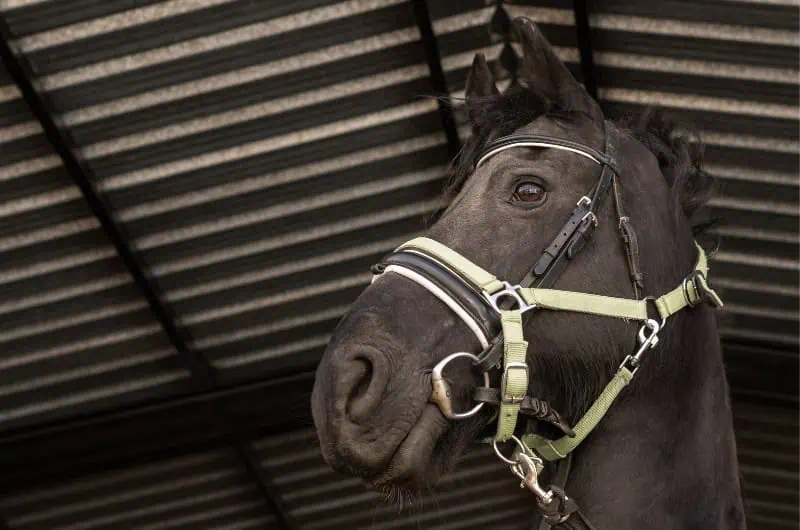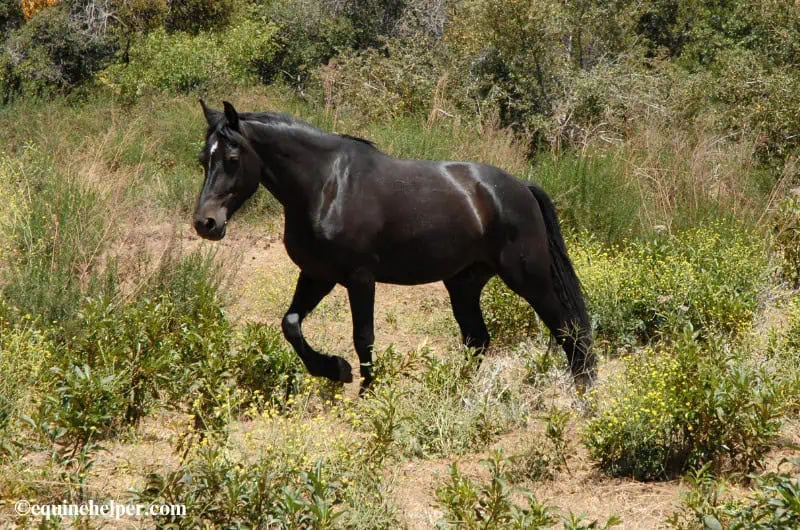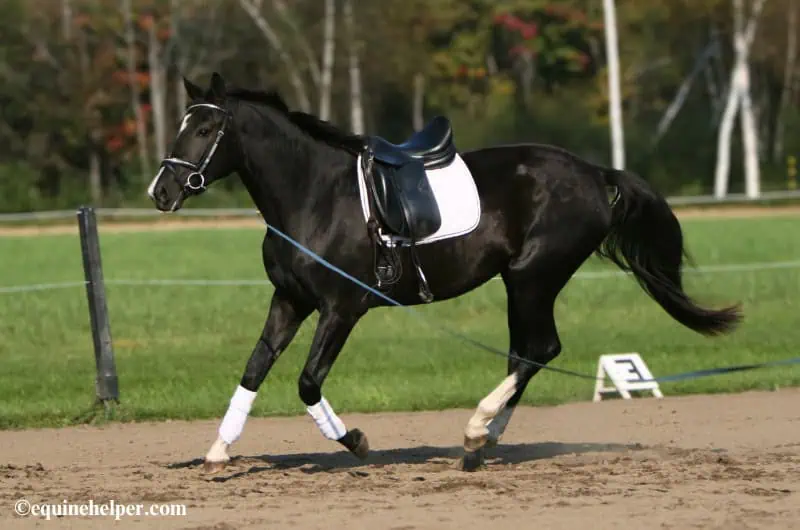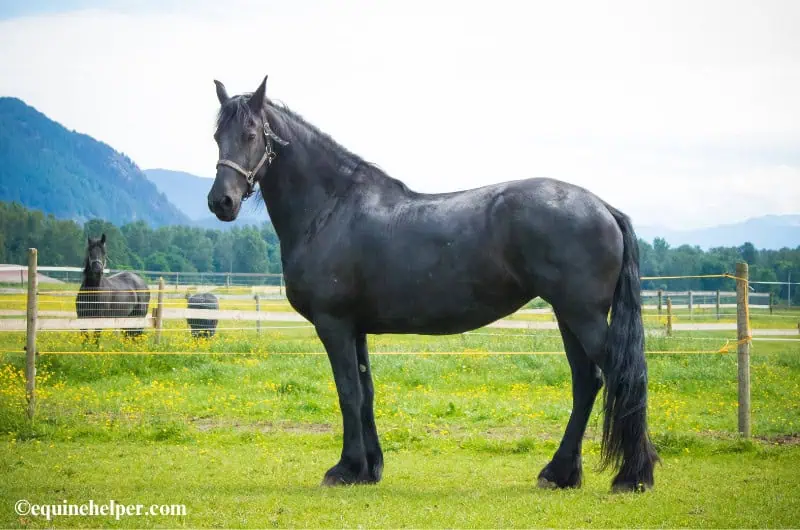Interesting Black Horse Facts
We’ve all seen one, whether in movies or in real life – the jet-black horse with the long mane flowing behind him as he canters around in the pasture. There’s something especially striking about a purely black horse.
What is so interesting about black horses? Despite what you may be led to believe by various movies, book series, and other media, purely black horses are not all that common. There are very few horse breeds that produce exclusively black horses, and only one that you may recognize.
Keep reading to learn thirteen interesting facts – all about black horses.
Black Horse Fact #1: Black Is One of Only Two Base Coat Colors
Considering that the color black represents a small percentage of horses, it may surprise you to learn that black is one of only two base colors. The two base coat colors in which a horse can be found are black and red.
Every coat color that you’ve heard of – including bay, chestnut, and gray – is a result of a specific gene (some known, and some unknown) acting upon either a black or red base coat.
One of the most common horse colors is bay, which is a reddish-brown body with “black points” on the feet, face, mane, and tail. This is an example of a gene acting upon a base coat color – in this case, it’s the Agouti gene over a black base coat.
Black Horse Fact #2: Not All Black Horses Are Really Black
Many horses that appear black to the eye aren’t really black at all, but rather a very dark shade of bay, chestnut, or “brown”. The hair of these horses may be so dark that they are almost indistinguishable from a black horse.
Truly black horses will have black skin and completely black coats with black hairs around the eyes and muzzle, while a dark bay or chestnut usually has reddish hairs around the eyes and muzzle.

Black Horse Fact #3: A Black Horse Can Fade
Then again, some truly black horses may, at times, appear a dark brown (are you confused yet?). Both sunlight and sweat can cause a “sun bleach” on a black coat, causing the hair to temporarily adopt a reddish tinge.
One may assume these horses are a bay or dark chestnut at first glance, but further inspection will reveal the truly black coat – like other horses, a black horse will show his true color around his eyes and muzzle.
That said, not all black horses are prone to sun bleaching. Black horses that fade are called “fading blacks”, while black horses that never lose their inky black coats are called “non-fading blacks”.
Black Horse Fact #4: Friesians Are the Most Common Black Horse Breed
When most people picture a black horse, it will be a Friesian that comes to mind. Friesians are large, jet-black horses with long and often wavy manes and tails. They have feathered feet and the only white marking allowed to be registerable is a small white star.
Despite the historically strict color breeding, there is a line of Friesians that can produce chestnut foals. These red Friesians are purebred but are nevertheless not allowed into the registry. There are, however, “cross registries” a red Friesian can enter – they are commonly referred to as “Fire Friesians” or “Fox Friesians”.
Black Horse Fact #5: There Are Very Few Exclusively Black Horse Breeds
Not only are Friesians the most common black horse breed, but they are also one of only a very few. The only other exclusively black horse breeds are the Murgese and the Ariegeois. The color black is very common, though not exclusive, in the Fell pony, the Dales pony, the Ostfriesen, the Alt-Oldenburger, the Kladruber, and the Groningen.
Of course, the color black can also be found in a great variety of other horse breeds, including Arabians, Thoroughbreds, and Quarter horses – though the most common colors in these breeds are generally bay, chestnut, and gray.
Black Horse Fact #6: Black Horse Breeds Are Mostly From Cold Climates
All of the horse breeds that are found exclusively, or most often, in black, are from the northern climates. This makes sense, because the color black absorbs and retains heat, making a black horse less suitable for a hot climate closer to the equator.
There may be intentional breeding involved in this, but this may also be a result of some natural selection. The Friesian, for example, is a very old horse breed and would have been developed using breeds native to the area at that time.
Black Horse Fact #7: Some Horses Are Found in “Smoky Black”
You know what a black horse is, but you may not have heard of a “smoky black”. This is the result of a cream gene over a black base coat and can be found on just about any breed that has the ability to produce foals with both black coats and dilution genes.
A true smoky black can range in color from pure black to a light bay color and is not easy to identify by the naked eye. For this reason, you may know a smoky black horse without ever hearing the term – DNA tests are usually needed to confirm this color.
Black Horse Fact #8: Black Foals Are Not Born Black
Black horses don’t generally start out black at all, but rather a mousy gray or brown. A black foal may not show his truly black coat until he’s three or four years old.
Some black horses will have primitive markings as foals that blend into the coat as it darkens with age – this means that primitive markings may be (but aren’t always) an indication that a horse will be black at maturity.

Black Horse Fact #9: Foals That Are Born Black Do Not Stay Black
To add to the confusion, a foal that is born black will likely not turn into a black horse, especially if that foal has at least one gray parent.
That’s because most gray horses are born black. Their coat fades into gray at maturity and then fades further to white as the horse ages. These foals, though black in color, will usually have white hairs around their eyes and muzzles.
Black Horse Fact #10: Two Black Horses Don’t Always Produce Another Black Horse
Despite the years of research into horse colors, the genetics are not yet well understood. What is known is that black is a dominant color, and if two black horses breed but each has the recessive chestnut gene, their foal may very well be a chestnut.
For those of you who took biology in high school, this is similar to two brown-eyed parents producing a blue-eyed baby if they each carry the recessive blue-eyed gene.
Black Horse Fact #11: Queen Elizabeth II Had A Prized Black Horse
In the 1960s, Queen Elizabeth II was gifted a black mare named Burmese by the Royal Canadian Mounted Police. Queen Elizabeth II was an avid equestrian and she loved Burmese – she rode her in the Trooping the Colour parade for eighteen years, from 1969 until 1986.
Black Horse Fact #12: The “Most Famous Fictional Horse” Is The Black Stallion
There are more than twenty books in The Black Stallion series written by Walter Farley, with the first debuting in 1941. The series follows “The Black” – a horse shipwrecked on a deserted island with a boy named Alec – his racing career and his future offspring.
The Black Stallion was once deemed “the most famous fictional horse of the century” by The New York Times, and appropriately so – the series has sold millions of books and has been published in more than twenty languages, not to mention the multiple successful movie adaptations.

#13: Another Famous Fictional Horse is Black Beauty
While each has its own merits, I can’t discuss the Black Stallion without bringing up Black Beauty. Black Beauty was first written in 1877 by Anna Sewell. Upon its release, it became an immediate best-seller, and it still is today.
The book has had many film adaptations over the years, though arguably its biggest contribution has not been to the world of entertainment at all but to animal welfare. The book introduced laymen to the hard life of a typical cab horse, and public reception led to real legal changes in the equipment used on these horses.
Black Horses Are Well-Loved, If Not Well-Represented
Black horses certainly receive a lot of attention despite their lack of representation among the larger horse population.
This is not hard to explain – even the most typical horses are naturally beautiful, and adding a jet-black coat to these majestic beings really brings the “wow factor”. Black horses (especially those with wavy manes and feathered feet) are incredibly striking – a sight to behold. If you’re getting a black horse and you’re stumped on the right name, here’s my article on 200 Black Horse Name Ideas!
The post Black Horses: 13 Interesting Facts appeared first on Equine Helper | Horseback Riding, Training, & Care.

